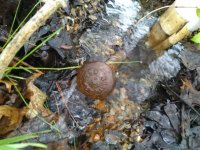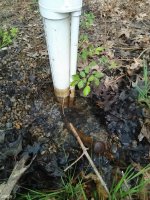MarkbNJ
New Member
Hey guys, I'm looking for some insight.. I'm wondering what this pipe running parallel to my well pump housing is?


I never noticed it before but the cap is leaking. I haven't had a chance to dig deeper but from what I felt, it threads into a piece of PVC that joins to (maybe poly pipe? As it bends fairly easily) that butts up next to the well pump housing and continues down.
What I'm wondering is A. What is the pipe/what's it tied to? And B. Is it likely that this leak is the issue I just noticed with low pressure in my system?
Back story - I just dewinterized my irrigation and noticed low pressure in virtually all zones. I went in the basement to check my pressure and I noticed it was sitting at 38psi and not cycling on/off as it should (my switch is 40/60). I let a sprinkler zone run and I turned on a sink and saw my pressure drop to about 20psi. I turned everything off and still heard/saw no movement on my switch but I was building pressure back up, just slowly to about 40psi then very slowly beyond that (never got to get back to it as company was over so I'm not sure what it built up to). Only other note worthy thing was the well pump line was humming (as if it was running or struggling to run) after everything has been closed.
Any advice would be greatly appreciated. Thanks in advance!
EDIT: Maybe it's worth noting - It's possible it may have gotten air bound or an air pocket when I pressurized the irrigation? My backflow preventer did leak a little at first and the line shook a little as I was running through the zones but it cleared itself out and nothing leaks now nor does anything shake.. but I don't see how that would cause this leak or have an effect on the pump. If it's airbound tho, I'm wondering if I can vent it at the gate valve that's like right next to the pressure tank. I should just be able to crack that to bleed the air. The other odd thing is the switch wasn't even cycling like it should of been when I was running the water as I stated prior to this edit.
I never noticed it before but the cap is leaking. I haven't had a chance to dig deeper but from what I felt, it threads into a piece of PVC that joins to (maybe poly pipe? As it bends fairly easily) that butts up next to the well pump housing and continues down.
What I'm wondering is A. What is the pipe/what's it tied to? And B. Is it likely that this leak is the issue I just noticed with low pressure in my system?
Back story - I just dewinterized my irrigation and noticed low pressure in virtually all zones. I went in the basement to check my pressure and I noticed it was sitting at 38psi and not cycling on/off as it should (my switch is 40/60). I let a sprinkler zone run and I turned on a sink and saw my pressure drop to about 20psi. I turned everything off and still heard/saw no movement on my switch but I was building pressure back up, just slowly to about 40psi then very slowly beyond that (never got to get back to it as company was over so I'm not sure what it built up to). Only other note worthy thing was the well pump line was humming (as if it was running or struggling to run) after everything has been closed.
Any advice would be greatly appreciated. Thanks in advance!
EDIT: Maybe it's worth noting - It's possible it may have gotten air bound or an air pocket when I pressurized the irrigation? My backflow preventer did leak a little at first and the line shook a little as I was running through the zones but it cleared itself out and nothing leaks now nor does anything shake.. but I don't see how that would cause this leak or have an effect on the pump. If it's airbound tho, I'm wondering if I can vent it at the gate valve that's like right next to the pressure tank. I should just be able to crack that to bleed the air. The other odd thing is the switch wasn't even cycling like it should of been when I was running the water as I stated prior to this edit.
Attachments
Last edited:



